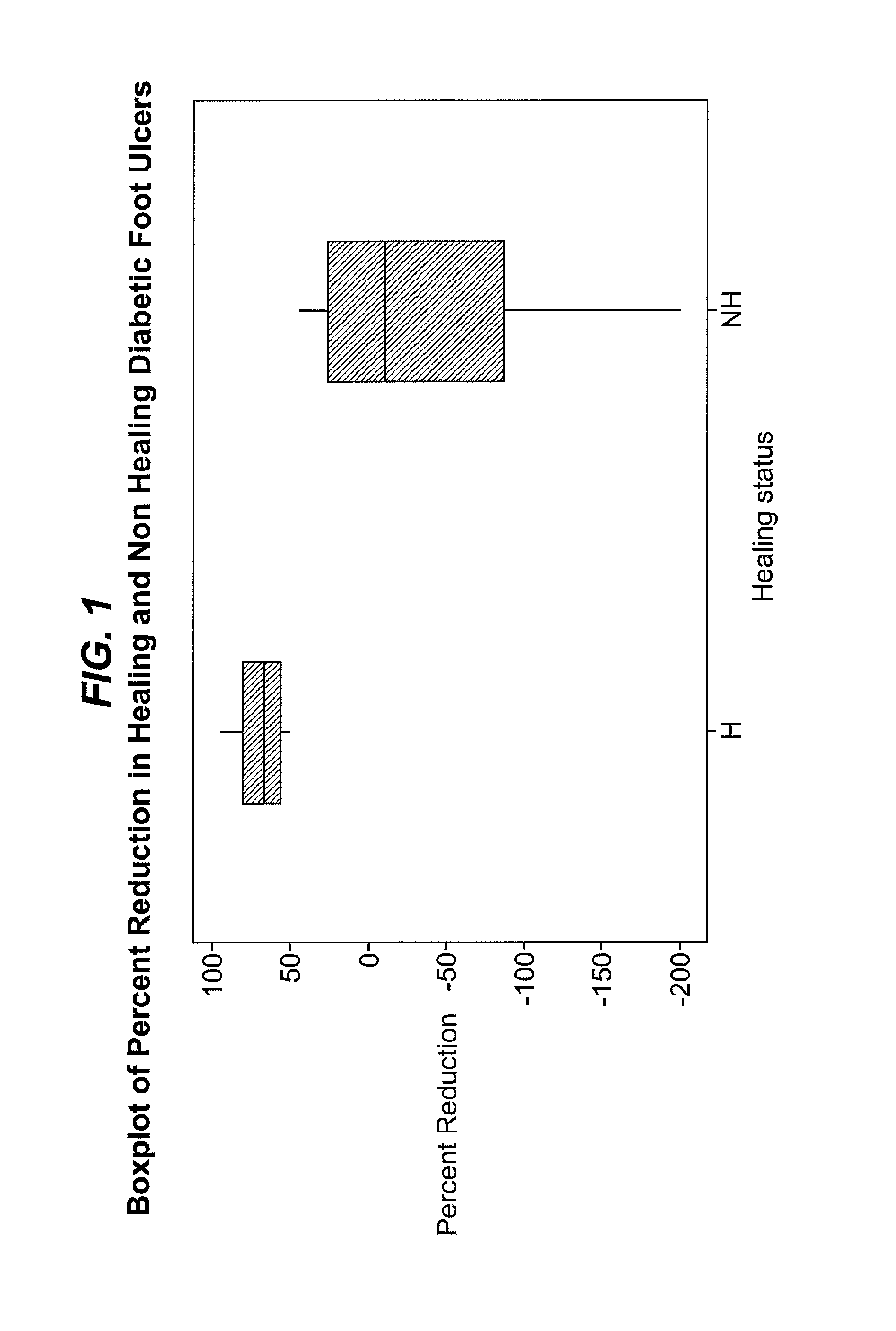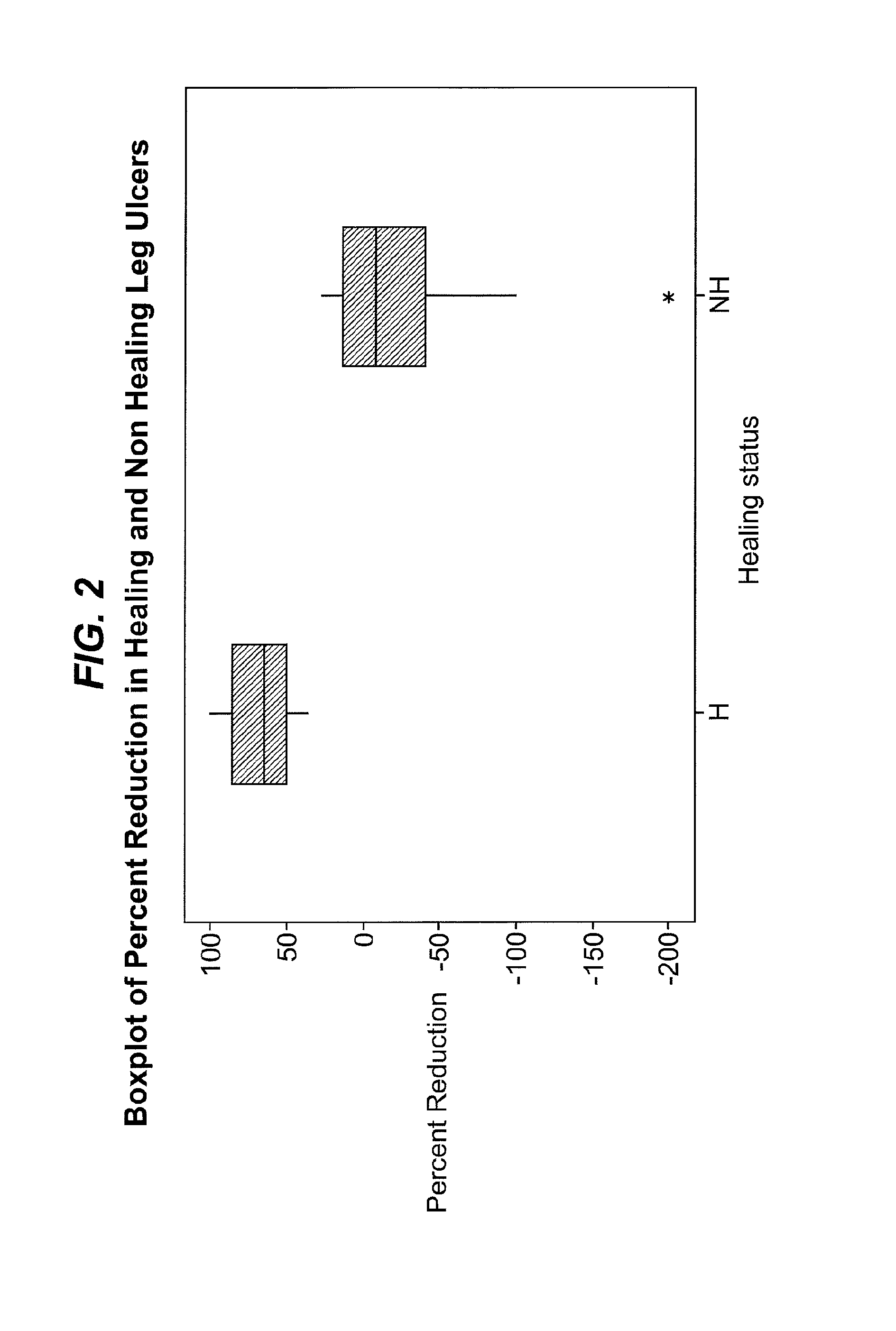Wound prognosis
a wound and prognosis technology, applied in the field of wound prognosis, can solve the problems of not showing how to use these markers to distinguish between healing and non-healing chronic wounds, the level of elastase and total mmp is significantly reduced, and the protease level in any sample of wound fluid appears to be poorly correlated, so as to avoid unnecessary oxidized cellulose therapy, improve wound healing, and maximize the effect of benefi
- Summary
- Abstract
- Description
- Claims
- Application Information
AI Technical Summary
Benefits of technology
Problems solved by technology
Method used
Image
Examples
example 2
Determining the Amount of Matrix Metalloproteinase by Protein Microarray
[0232]MMP-1 and MMP-9 in wound samples were quantified using FAST Quant protein microarray (commercially available from Whatman).
[0233]Different sets of arrays were printed on 16-pad FAST slides in triplicates using a piezo-electric Perkin-Elmer BioChip Arrayer. The arrays consisted of monoclonal antibodies against a variety of cytokines (up to 11 different cytokines were quantified per array). Arrayed slides were then inspected and stored in a desiccated room until required.
[0234]Prior to analysis, the slides were removed from storage and a 16-pad hybridization chamber was attached to the slides, and the slides were placed into a FAST Frame (4 slides per frame) for processing.
[0235]Arrays were blocked for 15 minutes at room temperature using 70 μL S&S Protein Array Blocking buffer. The blocking buffer was removed and 70 μL of each wound fluid sample (at a 1:20 or 1:50 dilution), standard or control was added.
[0...
example 3
[0239]Total protein present in each extracted wound fluid sample was determined using the Bradford protein assay. The protein binding solution comprises 1 ml Coomassie Brillant Blue stock solution 200 mg-Coomassie Brillant Blue G250, Sigma Chemical Co., dissolved in 50 ml ethanol-90%); 2 ml orthophosphoric acid (85% w / v); in a final volume of 20 ml with distilled water. This solution was filtered (Whatman #1 filter paper) and used immediately. The protein level in a sample wound fluid was measured by mixing 10-μl sample or standard with 190-μl of the protein binding solution in a microtitre well and incubating for 30 mins at ambient temperature prior to reading absorbance at 595 nm. The concentration of protein was estimated from a standard calibration of BSA (bovine serum albumin prepared in distilled water; Sigma Chemical Co.) ranging from 1.0 to 001 mg / ml.
example 4
Wound Sampling
[0240]Twenty six patients meeting the patient selection criteria disclosed above were enrolled, and wound fluid collected. Wound fluid was collected again after four weeks.
[0241]The amount of elastase-like activity (as indicated by the method of Example 1), MMP-1 and MMP-9 (as indicated by the method of Example 2) in the wound fluid of each patient was analysed immediately before wound treatment commenced.
[0242]Eighteen of the twenty six patients were then treated by application of PROMOGRAN PRISMA™ dressing to the whole surface of the ulcer, together with suitable secondary dressings to hold the PROMOGRAN PRISMA™ in place. The remaining eight control patients received “good standard care”. Patients were treated with a range of different dressings, including:
DressingManufacturerBrief descriptionPhysiotulleColoplastPhysiotulle is a non-adherent, non-occlusivepolyester net impregnated with hydrocolloid particlessuspended in Vaseline.Physiotulle AgColoplastnon-adherent, m...
PUM
| Property | Measurement | Unit |
|---|---|---|
| Fraction | aaaaa | aaaaa |
| Fraction | aaaaa | aaaaa |
| Flow rate | aaaaa | aaaaa |
Abstract
Description
Claims
Application Information
 Login to View More
Login to View More - R&D
- Intellectual Property
- Life Sciences
- Materials
- Tech Scout
- Unparalleled Data Quality
- Higher Quality Content
- 60% Fewer Hallucinations
Browse by: Latest US Patents, China's latest patents, Technical Efficacy Thesaurus, Application Domain, Technology Topic, Popular Technical Reports.
© 2025 PatSnap. All rights reserved.Legal|Privacy policy|Modern Slavery Act Transparency Statement|Sitemap|About US| Contact US: help@patsnap.com



